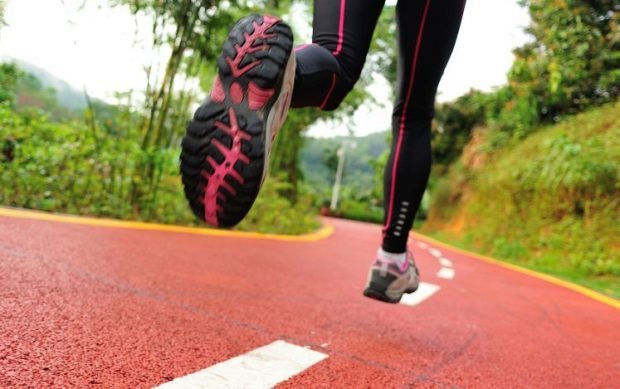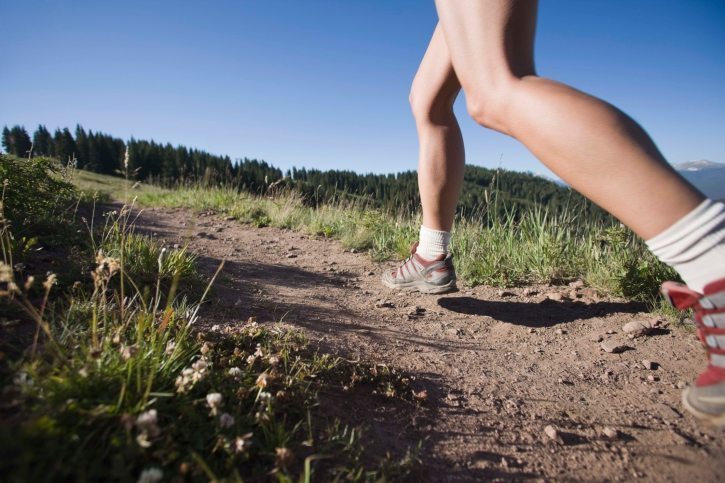
The weather is finally heating up, and if you’re looking to ramp up your running program, consider trail running. Essentially, it’s running on any off-road surface. Trail running offers a variety of terrain (you’ll really get in touch with nature as you breeze past it) and provides a more forgiving surface than running on asphalt. Best of all, outdoor running can give runners an opportunity to mentally check out when they get into “the flow.” Trail running expert Elinor Fish breaks down the fundamentals of the sport for us. And Fish has more than enough credentials to her name. She’s a former managing editor of Trail Runner magazine, running coach of 15 years, and now operates Run Wild Retreats–trail running and yoga retreats in the Colorado Rockies that teach the fundamentals of natural running technique for the trails, how to train for a trail race, fuel property and pace yourself for trail running. So, lace up your (appropriate trail-running) shoes and get started. Your mind and body will thank you.
1. Proper Shoes are Key
“Shoes are definitely a runner’s most critical piece of gear,” Fish says. “As any runner can tell you, a blister or ill-fitting shoe can have devastating effects and totally ruin a race.” If you’re not sure where to find proper shoes, Fish recommends heading to your local running store. The shops will typically employ experienced runners who can help you select the right shoe based on your running style, where you run, how much you run and your other specific needs.
Find great-fitting shoes for summer here.
“If you are going to be running trails all or most of the time, I do recommend a trail-specific shoe because it will have far better traction than a road shoe, plus a reinforced upper that will keep your foot stable on top of the shoe,” Fish says. “Light-weight road shoes with all-mesh uppers stretch out quickly and will soon feel ‘sloppy’ or unsupportive when you run on uneven and hilly terrain.”
2. Research trails before you run

“The best kind of trails for beginners are those with which you are already familiar or can access information about,” Fish says. You should ask yourself questions like: How long is the trail? Will you run out and back or make a loop? What is the elevation gain/loss? How difficult (technical) is the trail? “Usually, people must run a slower pace on trails because of the more difficult footing, which means that five miles off road can take a lot longer than five miles on the road. It’s important to know what you’re getting into so that you can properly plan how to pace yourself, how much water and food to bring,” Fish says.
Fish suggests using sites like trails.com or Alltrails.com to find places to run in addition to asking runners at your local running shop for ideas. Mountain biking trails often make great running trails as well—just be mindful to share the trail and step aside to let bikers pass.
3. Ensure you’re getting the right fuel
If you will be running for more than one hour, be sure to take small sips of water throughout the run. If you’re pounding the trails in hot weather or for longer periods, it’s imperative that you take in electrolytes. If you start to experience muscle cramps or sluggishness, electrolyte depletion is most likely the cause, according to Fish. If you don’t like sports drinks, try sugar-free Nuun tablets to add electrolytes to your water. In addition to your shoes, you’ll want to consider your hydration system. Some runners love waist belts, while others prefer light-weight packs with a bladders and others prefer hand-held water bottles. Fish recommends experimenting with different systems to decide which one works best for you. If you’re just getting started, some great brands of hydration systems include UltrAspire, Nathan, Ultimate Direction and Amphipod. For runs of 90 minutes or more you should carry calories like energy gels and chews.
Don’t forget about the importance of Post Workout nutrition, too!
4. Consider Your Pacing
“The biggest thing to consider when transitioning from roads to trails is efficiency. A number of things affect efficiency, most notably running form and pacing. If you try to power up steep hills or over technical terrain using long, muscle-driven strides, you’re likely going to exhaust yourself rapidly,” Fish says. To prevent premature exhaustion, Fish recommends taking shorter, quicker strides. Those tiny, quick steps also will help you get up a rocky climb or float over winding tree roots. If you’re worried about tripping, watch the ground carefully and try to step on top of the rocks or roots, rather than over or between them, Fish says.
5. Boost Your Body and Mind
If you really want to shake up your fitness routine, trail running may be an ideal solution.
“Being in a natural setting is such a completely different experience from running on a road (even a country road) that it can introduce you to a whole new world of adventure,” Fish says. “The most common ‘benefit’ to trail running people cite is that fact that soft trails are more forgiving on the body than running on asphalt. And, because the terrain is more variable, you better engage the core’s stability muscles and develop a more balanced stride.”
If you think you can only find a zen-like atmosphere in a yoga studio, think again.
“Due to the mental focus it takes to navigate most trails, it’s easier to get into a state of ‘flow’ or zone where your breath and rhythm of your feet carry you along and you forget the passage of time,” Fish says.
“Two hours on the trail seems like nothing compared to two hours on the road. Attaining that flow state can be one of the effective means to reduce stress and refresh your mind. It really works.”
For more in Fitness, check out our articles here.
Which do you prefer? Running on terrain, asphalt, or the treadmill?
All images via Thinkstock

Trail running definitely scares me a little bit and I think it’s because sometimes I just run too fast and lose control!! And then I fear I might twist my ankle and injury myself!! ha ha.
Hey Gigi Eats, I understand your fear of getting injured–I’ve certainly taken some tumbles over the years, but that’s also one of the great things about trail running. Not the getting hurt part, but that fact that it requires a bit more attention of what’s right in front of you. When you’re busy thinking about where to place your foot, or how to navigate through a rocky, rooty section of trail, you’re not thinking about the zillion other things that may otherwise occupy your mind.
I personally find it so liberating and refreshing in a way that road running doesn’t offer.
Has anyone else experienced that?
Wow! Wow! Wow! What a beautiful place! It is so great to see you and the boys in your evnrionment! Your sons are so beautiful and vibrant! They are so blessed to have such a wonderful childhood! The little hideaway is almost surreal! I will write back soon. I really enjoy our communication and learn so much from you and deepen my reflexion about our traveling plans.Love to you and your beautiful family!Tell your husband he should try to speak French to the boys as much as possible. Now that they speak Spanish, French will be so easy to learn and it is part of who they are!